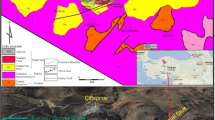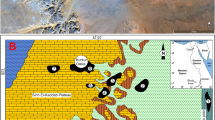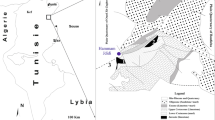Abstract
This paper presents petrographic and geochemical data from a Quaternary tufa deposit and associated hot-spring water from the Zerqa-Ma’in area of the eastern side of Jordan Rift Valley. The Zerqa-Ma’in phytoherm tufa is formed by encrustration of mosses and algae in which the rate of calcite precipitation is probably controlled by water turbulence. Calcite precipitates mainly as fibrous crystals containing an appreciable amount of crystallites and inclusion-rich zones. Trace element analysis of the tufa shows high concentrations of Sr and Mn which were probably derived from leaching of Triassic Ca-sulphates in the area and the mosses in the tufa, respectively. CaCO3 saturation index (S.I) values of the water indicate that the calcite in Zerqa-Ma’in tufa is precipitated mainly from biogenic activities.
Similar content being viewed by others
References
AL-MUHSSEN, M., 1990, Petrogenesis of Quaternary basalts from the central part of the Jordan Rift valley and some areas in Northwest Jordan. Unpublished Master of Science thesis, Yarmouk University, Irbid.
BARBIERI, M., MASI, U., and TOLOMEO, L., 1979, Origin and distribution of strontium in the travertine of Latium (central Italy):Chemical Geology, v. 24, p. 181–188.
BUCCINO, G., DA’RGENIO, B., FERRERI, V., BRANCACCIO, L., FERRERI, M., PANCICH, G., and STANZIONE, O., 1978, La travertine della bassa valle del tangro (Camparria) studio geomorphologia, sedimentologiae geochemico: Boll. Socx Geo., v. 97, p. 617–646.
BUCHBINDER, B., 1981, Morphology, microfabric and origin of stromatolites of the Pleistocene precursor of the Dead Sea. Israel, in Monty, C. (ed.), Phanerozoic stromatolites, Springer-Verlag, Berlin, p. 181–196.
BUCHBINDER, B., BEGIN, Z.B., and FRIEDMAN, G.M., 1974, Pleistocene algal tufa of Lake Lisan, Dead Sea area, Israel:Israel Journal of Earth Sciences, v. 23, p. 131–138.
CHAFETZ, H.S. and BUTLER, J.C., 1980, Petrology of recent caliche pisoliths, spheruilites and speleothem deposits from central Texas:Sedimentology, v. 27, p. 497–518.
CHAFETZ, H.S., UTECH, N.M. and FILZMAURICE, S. P., 1991, Difference in the δ18O and δ13C signatures of seasonal laminae comprising travertine stromatolites:Journal of Sedimentary Petrology, v. 61, p. 1015–1028.
EMEIS, K.C., RICHNOW, H.H. and KEMPE, S., 1987, Travertine formation in Plitvice natural park, Yugoslavia: Chemical versus biological control:Sedimentology, v. 34, p. 595–609.
HARVEY, J.C., 1982, The properties of ground water. John Wiley Publication, New York, 406 p.
IRION, G. and MÜLLER, G., 1968, Mineralogy, petrology and chemical composition of some calcareous tufa from the Schwabische Alp, Germany, in Muller, G., and Friedman, G.M., (eds.), Recent developments in carbonate sedimentology in central Europe. Springer-Verlag, Berlin, p. 157–171.
LOVE, K.M. and CHAFETZ, H.S., 1990, Petrology of Quaternary travertine deposits, Arbuckle Mountain, Oklahoma, in Hermann, J. S., and Hubbard, D. A., (eds.), Stream deposits in Virginia. Virginia division of mineral resources, publication 101.
PEDLEY, H.M., 1987, The Flandarion (Quaternary) Caerwys tufa, North Wales: an ancient barrage tufa deposit:Proceeding of the Yorkshire Geological Society: part 2, v. 46, p. 141–152.
PEDLEY, H.M., 1990, Classification and environmental models of cool fresh water tufas:Sedimentary Geology, v. 68, p. 143–154.
RAO, C.P., 1990, Petrography, trace elements end oxygen end carbon isotopes of Gordon Group carbonates (Ordovician), Florentine Valley, Tasmania, Australia:Sedimentary Geology, v. 60, p. 221–231.
RASHDAN, J., 1985, Hydrological conditions, thermal and mineral springs at Zerqa-Ma’in and Zara area, Jordan. Unpublished. Report, Water Authority, Amman.
RIMAWI, O., 1980, Geochemistry and isotope hydrogeology of the thermal springs along the eastern side of the Jordan Dead Sea. Unpublished. Master of Science Thesis, University of Jordan, Amman.
RIMAWI, O. and SALAMEH, E., 1988, Hydrochemistry, and ground water system of Zerqa-Matin. Zara thermal field — Jordan:Journal of Hydrology, v. 98, p. 147–163.
WEIJERMARS, R., BLANKEN, C.W., and WIEGRES, J., 1986, Growth rate observation from the moss-built Checa travertine terrace, Central Spain:Geological Magazine, v. 123, p. 279–286.
Author information
Authors and Affiliations
Rights and permissions
About this article
Cite this article
Banat, K.M., Obeidat, O.M. Notes on biogenic tufas associated with the Zerqa-Ma’in hot springs of Jordan. Carbonates Evaporites 11, 213–218 (1996). https://doi.org/10.1007/BF03175639
Received:
Accepted:
Published:
Issue Date:
DOI: https://doi.org/10.1007/BF03175639




